Universities, Colleges, Private Schools and Academia
The 1941 Slide Rule Queen
This honor was bestowed by my home state's university, the University of Rhode Island.
Posted By: Paul - Fri Jul 19, 2024 -
Comments (3)
Category: Awards, Prizes, Competitions and Contests, Beauty, Ugliness and Other Aesthetic Issues, Science, 1940s, Universities, Colleges, Private Schools and Academia
How many books do college students read?
We previously met Suellen Robinson as Miss Biological Research. Here she's posing by a stack of books that represents the number of books an average coed supposedly would read (back in the 1960s) during her four years at college. The number is 376.Officials of the Renault car company somehow arrived at this figure when they decided to sponsor a National College Queen Contest.
To read that many books a student would need to finish two books a week during the school year, and a book a week during Summer break.
I'm skeptical that the average college student (either back in the 1960s or now) reads anywhere close to that number. Perhaps they're assigned that many (though even that seems a bit high), but they're not reading them.

Orlando Evening Star - Apr 29, 1964
Posted By: Alex - Sun May 19, 2024 -
Comments (1)
Category: Education, Universities, Colleges, Private Schools and Academia, Books, 1960s
Voo Doo Magazine
Would you expect the Massachusetts Institute of Technology to feature an extant humor magazine, whose first issue was published in 1919? Well, it's a fact.You can read scores of issues here.


Posted By: Paul - Tue Mar 19, 2024 -
Comments (10)
Category: Humor, Magazines, 1910s, Universities, Colleges, Private Schools and Academia
Does college turn young women into communists?
Back in the 1930s families were concerned about whether they should send their young daughters off to college, fearing they might come home infected with communism. So in 1934, psychologist Stephen M. Corey set out to determine whether such fears were justified.Corey administered the Thurstone Attitude Scale to 234 female freshmen at the University of Wisconsin, examining their attitudes with respect to six topics: Reality of God, War, Patriotism, Communism, Evolution, and Church. A year later he retested 100 of these students when they were sophomores.

Godless communists?
When he presented his findings at the Midwestern Psychological Association convention in May 1940, he assured everyone that it was safe to send young women to college, saying, "There was no great difference in the girls' attitudes. The average co-ed apparently would rather mix with stag lines than picket lines."
He also emphasized that the young women lost none of their feminine habits at college. A United Press reporter paraphrased his words:
However, if you look at his 1940 article in the Journal of Social Psychology*, in which he published the results of his study, you find somewhat different information. There he revealed that after a year at college the attitudes of the young women did change slightly, but consistently, in the direction of liberalism — which is to say that they showed less sympathy for god, war, patriotism, and the church, and more sympathy for communism and evolution.

Corey wrote in that article, "The opinions of the students appeared to have undergone at least a degree of liberalization during their one year of attendance at a University."
I guess he wasn't actually lying to the folks at the Midwestern Psychological Association. It's all how you choose to spin the data.

San Bernardino County Sun - May 5, 1940
* Corey, S.M. (1940). "Changes in the opinions of female students after one year at university." The Journal of Social Psychology, 11: 341-351.
Posted By: Alex - Wed Aug 17, 2022 -
Comments (4)
Category: Psychology, 1930s, Women, Universities, Colleges, Private Schools and Academia
The May Queen of the Pennsylvania College for Women

Flanked by her attendants, May Queen Anna Negley '27, sits on her seashell throne. By the mid-1920s, Pennsylvania College for Women held a May Day pageant every other year. The 1927 pageant had an undersea theme and featured a magic throne, pirates, Neptune, Davy Jones, mermaids, and other sea people. Titled, “Deep Sea Caverns,” the festival was written by Helen Gordon ’28 and Ethel Hamilton ’28 (Hamilton passed away before graduating.). Vanda Kerst once again directed the production and designed the costumes.
Posted By: Paul - Tue Aug 02, 2022 -
Comments (2)
Category: Beauty, Ugliness and Other Aesthetic Issues, Contests, Races and Other Competitions, Oceans and Maritime Pursuits, 1920s, Universities, Colleges, Private Schools and Academia
Oklahoma U. Engineers’ Queen
Apparently the University of Oklahoma has a long tradition of the Engineering Department electing a queen, and then risking her being kidnapped by the Law School.Read a history of the OU Engineering School here.
I found a pretty recent reference to the continuation of the Queen's election, but not necessarily the kidnapping.

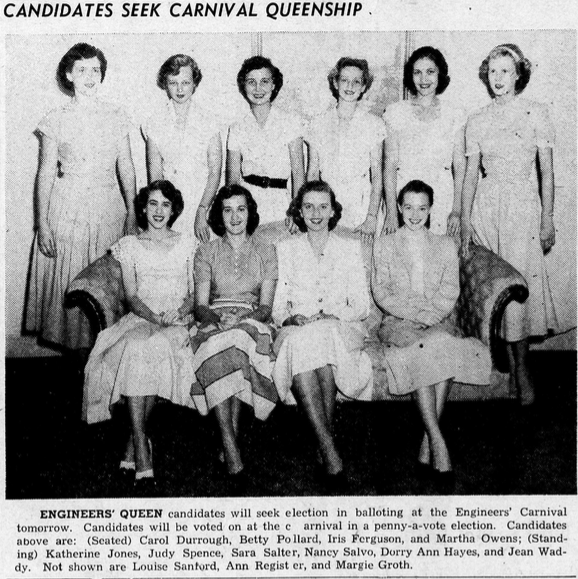
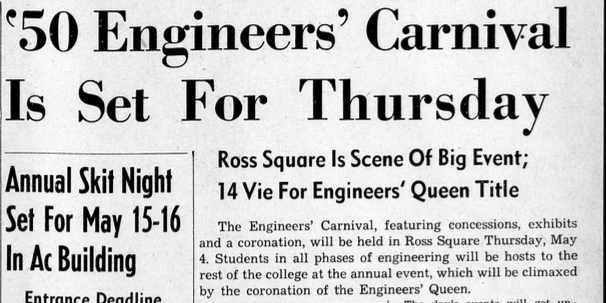


Posted By: Paul - Thu Mar 31, 2022 -
Comments (1)
Category: Awards, Prizes, Competitions and Contests, Beauty, Ugliness and Other Aesthetic Issues, Regionalism, Rivalries, Feuds and Grudges, 1920s, 1930s, 1950s, Universities, Colleges, Private Schools and Academia, Twenty-first Century
Non-Conformist in Classroom
Dec 1939: To disprove the contention of philosophy professor Albert Shepard that "everyone is a conformist," NYU student Rhoda Shafter showed up to his class in a bathing suit.I like the bewildered look on the face of Prof. Shepard, lurking in the background of the photo below.

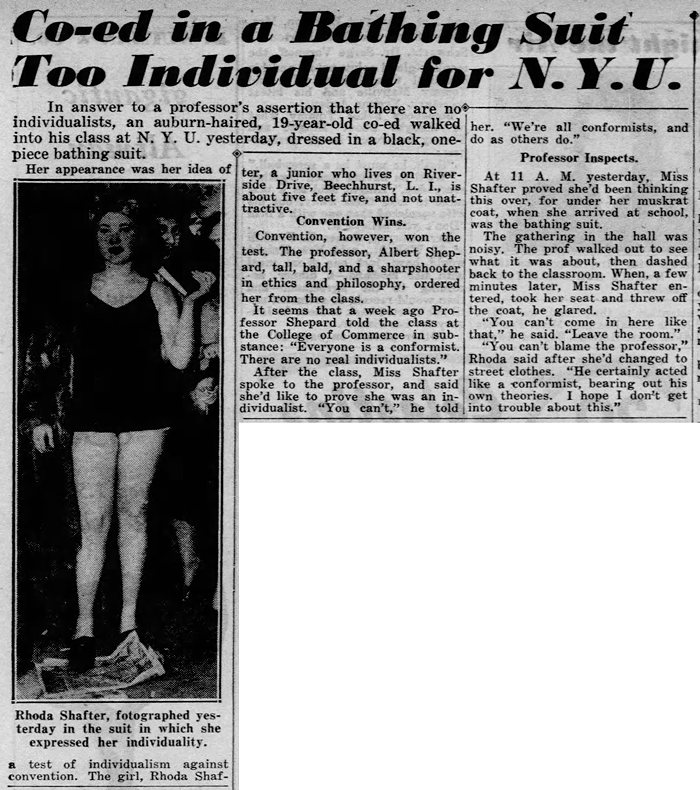
New York Daily News - Dec 21, 1939
Rhoda died in 2012. Read her obituary here.
Posted By: Alex - Sat Dec 18, 2021 -
Comments (2)
Category: 1930s, Universities, Colleges, Private Schools and Academia
The Tax Centinels
April 1938: Students at Renselaer Polytechnic Institute managed to acquire almost all the pennies in the town of Troy, New York — around 250,000 pennies in total. They did this by first going around store-to-store claiming they needed pennies for a "penny-ante poker game." Then they went to the banks and purchased their entire supply of pennies. Since each bank was unaware that the same thing was occurring at all the other banks, they happily sold the students all the pennies they had.As a result, the town of Troy suddenly discovered that it was in the grip of a "penny famine." Shopkeepers found themselves unable to make change. And more significantly, they found it difficult to charge the state sales tax.
This had been the point of the stunt. It had been organized by a group of students calling themselves the "Tax Centinels" in order to "focus public attention on the taxes which they claim account for 25 per cent of the cost of all necessities of life."
Having cornered all the pennies, the students went into the town the next day and began making purchases, using pennies to pay for one-quarter of whatever the cost of the item was. It was a bit like the time-honored stunt of paying fines with pennies.

Philadelphia Inquirer - Apr 6, 1938
The movement quickly spread to other colleges, so that other college towns were soon beset by penny famines. New members of the Tax Centinels were required to take the following pledge:
It shall be the purpose of this organization to focus public attention on the evils of the practice of keeping concealed taxes and to awaken in the public consciousness a realization that 70 per cent of all taxes now collected by more than 175,000 separate taxing bodies in the United States are obtained through secret levies tacked on to the price of necessities we all must buy daily—food, clothing, shelter, luxuries, and semi-luxuries.
Since the average man does not realize the inroads made upon his purse by these vicious hidden taxes and that he himself pays the major costs of the government instead of the Rockefellers, Morgans and du Ponts, I hereby pledge myself to pay 25% of the price of all purchases in pennies in order to dramatize the situation to the end that it may be remedied.

Wisconsin State Journal - Apr 11, 1938
As far as I can tell, the Tax Centinel movement lasted a month or two before fizzling out. But it seems to have been symptomatic of a widespread popular discontent at the time over the sales tax. See, for instance, our earlier post about the guy who in 1939 took a case all the way to the supreme court over his indigation at having been, in his mind, unfairly charged one-half cent of sales tax.
More info: "Tax Centinels," Star and Lamp (Pi Kappa Phi newsletter) - May 3, 1938. Page 4.
Posted By: Alex - Thu Sep 30, 2021 -
Comments (3)
Category: Money, 1930s, Universities, Colleges, Private Schools and Academia, Pranks
The Piano-Smashing Fad
The fad of piano smashing reportedly began in 1963 at a technical school in Derby, England, but it quickly spread to American campuses via Caltech, where a "Piano Reduction Study Group" was formed.The goal of piano smashing was "to reduce the piano, in the shortest possible time, to such a state that it may be passed through an aperture of 20 cm. in diameter." This was to be done by a maximum of six people using tools no heavier than 15.4 pounds each.
A record-setting time was achieved by students at Wayne State University who smashed a piano and passed it through a hole in 4 min 51 sec.
I wonder if this college fad was the inspiration for the Destructivist Art Movement, which emerged three years later, and also involved smashing pianos.

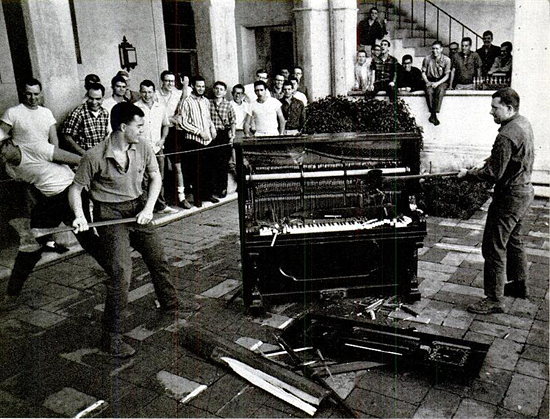
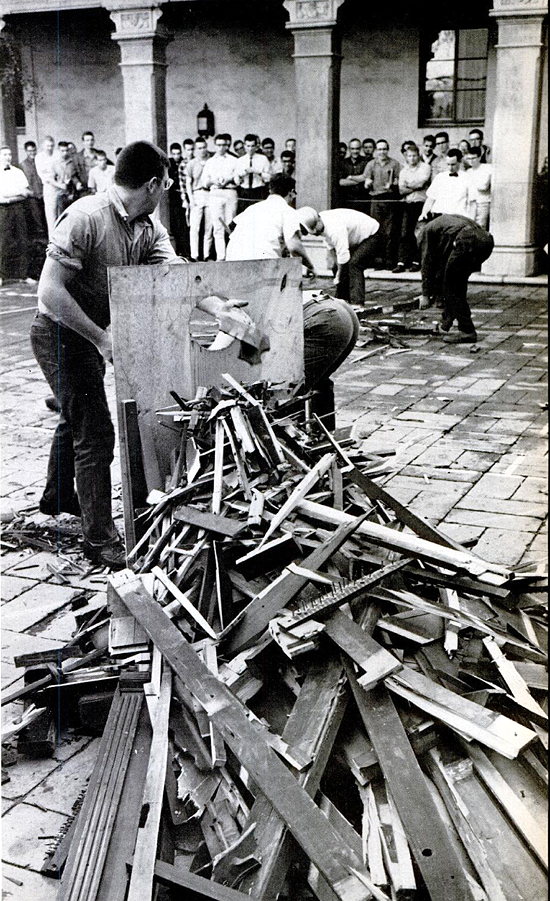
Source of images: Life - Mar 8, 1963
Posted By: Alex - Wed Sep 29, 2021 -
Comments (4)
Category: Fads, 1960s, Universities, Colleges, Private Schools and Academia
Cigarettes & Knickers: Forbidden
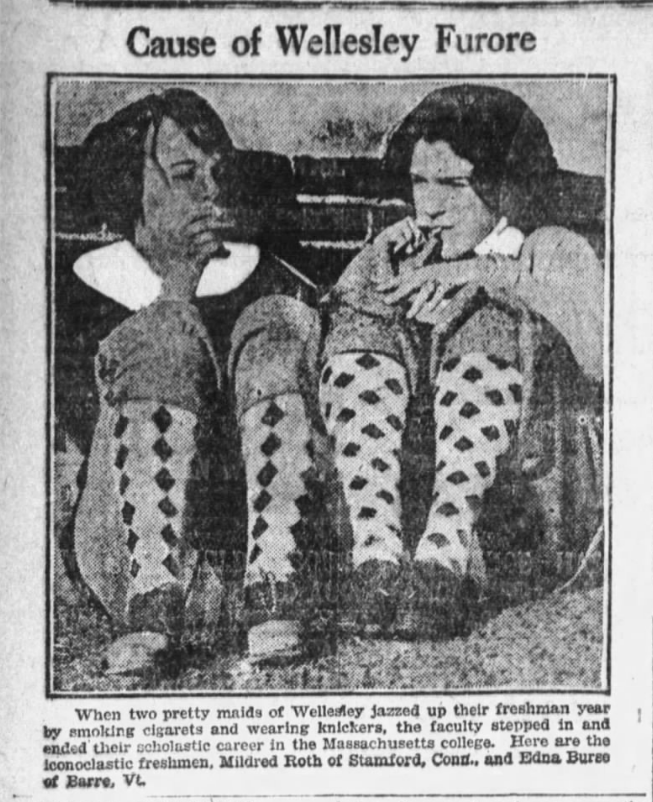
Source: Parsons Daily Republican (Parsons, Kansas) 12 Nov 1922, Sun Page 4
Posted By: Paul - Tue Mar 30, 2021 -
Comments (4)
Category: Misbehavior, Rebellion, Acting-out and General Naughtiness, Bohemians, Beatniks, Hippies and Slackers, 1920s, Universities, Colleges, Private Schools and Academia

| Who We Are |
|---|
| Alex Boese Alex is the creator and curator of the Museum of Hoaxes. He's also the author of various weird, non-fiction, science-themed books such as Elephants on Acid and Psychedelic Apes. Paul Di Filippo Paul has been paid to put weird ideas into fictional form for over thirty years, in his career as a noted science fiction writer. He has recently begun blogging on many curious topics with three fellow writers at The Inferior 4+1. Contact Us |




